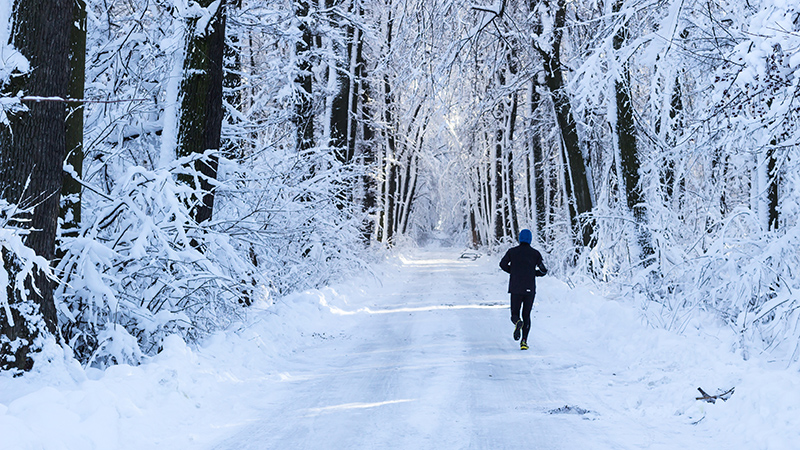How Cold Is Too Cold To Run?
For some people, when the weather gets cold, their running routines come to a screeching halt. For some, the chill is unbearable, but for others, the weather is just impractical. Either way, droves of runners lose their momentum in the cold winter months and they end up spending each spring starting over and building up their endurance again. But does it really have to be this way?
Contents
My favorite running season is winter. But, that’s because the summer heat and humidity in my location is both a nightmare and a health risk for long distance running. Not to mention, my winters aren’t near what other areas experience to freezing temperatures. On a more extreme day, I might experience freezing temperatures whereas others might experience temperatures in the negatives. So, all of this got me thinking… Is there a reason for a winter slump for runners?
Do people stop running outdoors out of complete necessity because it is too cold or simply because of discomfort? Is there a certain temperature or weather condition that deems it unsafe to run in the winter? How cold is too cold to run? Let’s explore this…
How Cold Is Too Cold To Run Outside?

The first determining factor in figuring out how cold is too cold to run outside is simply preference. Like I mentioned above, runners have an array of preferences in determining how cold is too cold to run. With myself in a warmer climate, I love winter runs because it rarely dips below freezing. But, I also love it because of the crisp air. However, some runners don’t like that level of frigid air and there are others who thrive in 10-20 degree weather. So, no matter what the experts suggest, you may have your own internal meter that determines what is too cold to run in, and that is okay!
When thinking about what is actually too cold to run in, there are some accepted rules. First, most suggest never running in temperatures below zero degrees Fahrenheit. However, this is just a starting point. There are other equally important factors that could impact your run that you’ll need to take into consideration to make sure that your run is safe and successful beyond just the temperature.
Wind Chill or Temperature?
If you’re determining whether it’s safe to run in hot temperatures, consider sunlight, humidity, and other factors that can increase your risks of getting hurt. The same rule applies when thinking about running in cold weather. There is a significant difference between a day where the temperature is 10 degrees and it’s sunny with no wind and a day where the temperature is 10 degrees and cloudy with 10 miles an hour winds.
It’s important if you’re determining how cold is too cold to run for yourself that you factor in the wind chill. In my example above, the sunny day in 10 degree weather would feel like 10 degrees or even more depending on the sun. However, the day where the wind is blowing 10 miles an hour in 10 degrees would feel like -3.5 degrees, which puts you at risk for hypothermia and other dangers.
So, if you’re deciding whether to go for a run, check the temperature, but also make sure that you check the conditions and wind chill because that might make a tremendous difference in your safety and the quality of your run.
Risk versus Rewards

There are some wonderful things about running in the cold. You don’t have to worry about heat strokes and other very serious complications from heat, but there are also some incredible risks that many people may not consider when running in cold weather, with hypothermia and frostbite being the biggest.
Hypothermia
Believe it or not, hypothermia can become a risk in running in temperatures starting at 45 degrees or below. Hypothermia is when your core body temperature dips below 95 degrees Fahrenheit and can cause disorientation, numbness, and even cardiovascular complications if not monitored properly.
Of course, there are things you can do to prevent hypothermia, like dressing appropriately and avoiding running in the cold while it is raining or with damp clothing. Even if you take all the precautions, it’s important that you make sure not to run in subzero temperatures (or wind chills) as this can significantly increase your risk of this potentially harmful condition. Not running in sub-zero temps (or wind chills) is a critical factor in knowing how cold is too cold to run outside.
Frostbite
Frostbite is another dangerous condition that could result from running outside when it is too cold to run. In temperatures below freezing, you can run a risk of parts of your body freezing, but the risk is smaller than hypothermia. Your fingers and toes are most at risk of frostbite when running, so if you decide to run in the cold, make sure that you have your gloves and thick, warm, dry socks. Being prepared can significantly decrease your risk.
Dress Adequately

Some runners believe that there is never bad weather, only bad clothing choices, and I completely see where they are coming from. If you want to run in cold weather, you have got to dress appropriately for the temperatures and wind chills you are preparing to face.
Like I mentioned above, if the weather is at or below freezing (32 degrees F), you will need to make sure you wear gloves and thick socks to keep your extremities warm and prevent frostbite. You also need to make sure that your whole body is warm enough, but not too much to the point you become overheated.
The best advice I ever received was to dress like the temperature is 10-20 degrees warmer than it actually is. For example, if you’re running in 35 degree weather, plan for it to feel like it’s around 50 degrees. The reason for this is that our bodies will warm up as we are running, especially on longer runs, and if you don’t account for this natural warming process, you will get too hot.
Now, of course, as it gets into the colder temperatures and you get closer and closer to 0 degrees, you will need all kinds of accessories to keep warm, including ear warmers or a hat, gloves, thick socks, and more. For frigid temperatures, think in terms of layers, so if you warm up, you can easily adjust while also being prepared for the bitter chill!
Fuel Up & Hydrate
If you’re wanting to have a successful run in the cold of winter, you’re going to need to make sure that you adequately fuel and are hydrated. In cold weather, you’re going to have fewer cues that you need water. You won’t sweat as much and you won’t feel as hot. This can actually be dangerous because without the cues, your body may not realize you still need hydration!
Make sure that if you’re running in cold weather, you stay adequately hydrated. Some suggest that you drink about one bottle of water per hour of exercise to avoid dehydration and the complications that come with that.
Along with this, make sure that you are properly fueled as well. Eat before your run, during the run if it is longer than 45 minutes to an hour, and afterwards to make sure you reap all the benefits of your workout.
Stretch & Warm Up Inside

The point of stretching and doing a warm up is to get your blood flowing and your body prepared for a workout. If the weather is freezing, doing this inside might actually help better prepare you for the harsh weather outside.
In the warmer temperatures indoors, your body will heat up more quickly and the cold won’t feel as cold. You can easily warm up by doing some jumping jacks, jump roping, or even walking or jogging on a treadmill. If you want a successful run in the cold, make sure you try to stretch and warm up inside! I think it will surprise you at how big of a difference this can make!
Use Time Instead of Distance Ran
I always think of the winter months as a maintenance phase. It isn’t time to work on your speed or go out for incredibly long distances you haven’t done before. In reality, that may not be the safest option for you depending on your location and how cold it gets.
So, if you’re running in especially cold climates, you might make things work better if you focus on the time ran instead of the distance. This could also be great for a person who wants to run in the cold but just has a personal aversion to it. Instead of dreading that “5 mile run”, you could tell yourself, “I’m going to run for 20 minutes”. Then, you can work up your length of outdoor running instead of the distance you need to go.
Consider Indoor Exercises

On the days when it genuinely is too cold to run or you simply don’t want to endure the bone-chilling cold, you might move your workout indoors. While this may seem counterintuitive to this whole article, it really isn’t. If your goal is to be healthy and maintain your fitness in the winter months, you might explore alternatives for days that simply are too cold.
Thanks to Youtube, the Internet, and Apps on our mobile phones, there are countless resources for indoor training. Consider a no equipment necessary HIIT class. You can take a yoga class. You can find any class that your heart desires, even if you don’t have the proper tools.
If you’re wanting to keep up your endurance and continue running indoors, you could look into investing in a treadmill or other form of equipment. For treadmills, specifically, you can find them at all price points and sizes from under $1000 to under $2000 if you can stretch your budget a bit more.
Wrap-Up
It can be tough when trying to decide – how cold is too cold to run.. Above, we cover 7 tips that will help with cold weather running – should you decide to venture out. We also touched on and discussed how cold is too cold to run outside – which is critical to know in areas that get below zero temps and wind chills. With the above tips and safety measures, you should be armed with the info you need to run safely outside through winter into spring!
